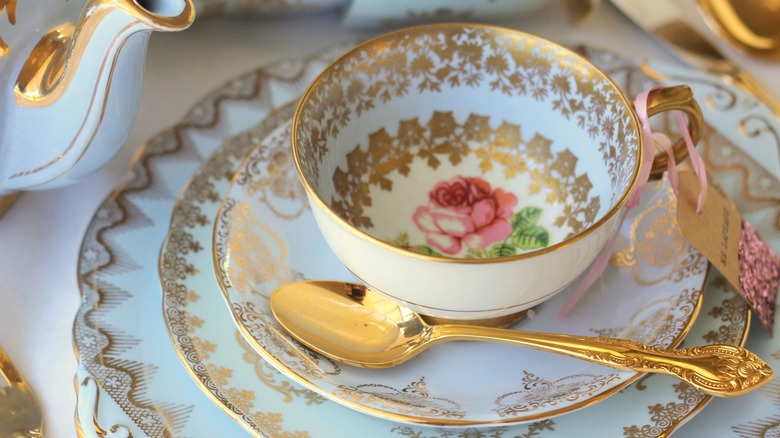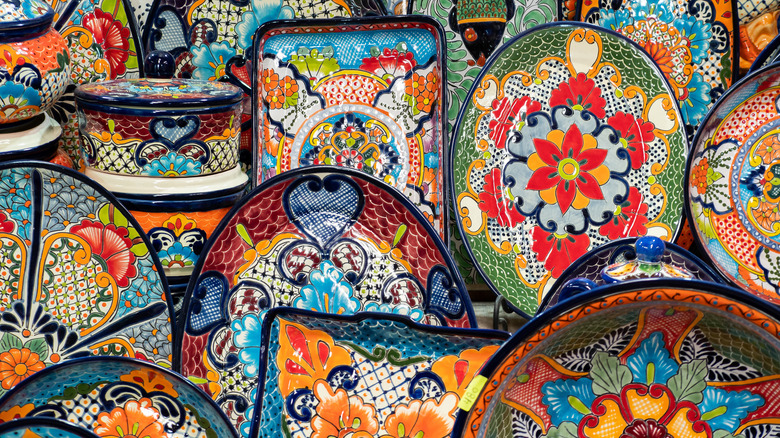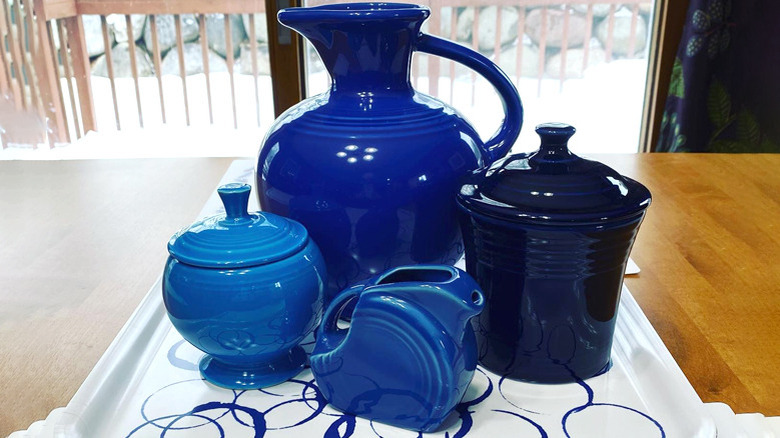The Toxic Red Flag To Look Out For With Vintage Dinnerware
Vintage dinnerware is fun to collect and adds such a lovely touch to your table settings. Whether thrifted, purchased from flea markets, or inherited, there's no denying the pride and joy of owning a beautiful set of fine china or a mishmash of antique porcelain cups and saucers. Unfortunately, there's a very real and hidden danger in some of these items, gorgeous as they may appear. Many pieces of older ceramics and pottery contain unsafe levels of lead (or uranium) and using them to eat or drink can expose you and your family to poisoning.
Lead is a toxic metal that was once commonly found in paint and glaze used to make plates, cups, and serveware. It can leach into food and drinks it comes into contact with, and, when consumed, is detrimental to human and animal health, as per the World Health Organization. There are no safe levels of lead, as determined by the FDA. Similarly, the EPA states no ceramics or glass containing uranium should hold food or drink — though you're unlikely to get seriously ill from them.
While you can't tell just by looking at a random piece of dishware whether it is contaminated or not, there are some red flags to be aware of. The first is age. The FDA first regulated lead levels in ceramicware in 1971, with stricter guidelines issued in 1992. To be on the safe side, avoid serving food on any vintage ceramics from before this period unless proven to be lead-free.
Antique and imported tableware is particularly risky
Before regulations were established, lead was extensively used in paint and glaze used to decorate crockery. The FDA warns of problematic ceramics and pottery based on additional red flags, including most antiques and handmade dinnerware. It's also important to look out for pieces that show heavy wear or damage, resold items from thrift stores or flea markets, and any decorations that have been painted in bright red, yellow, or orange, as lead is often used to saturate these colors.
Although modern dishware manufactured in the USA is not likely to contain lead, other countries are not regulated by American laws, and therefore many pieces produced in other parts of the world are still being made with high levels of contaminants. The FDA's "Red List" provides guidance for agencies regarding ceramics imported from other countries that may have dangerous levels of lead or other toxins. Flagged countries include Bolivia, Canada, China, Czechia, Ecuador, France, Germany, Greece, Hong Kong, Hungary, Indonesia, Israel, Italy, Japan, Korea, North Macedonia, Malaysia, Mexico, Morocco, Peru, Poland, Portugal, Russia, Saudi Arabia, Slovenia, South Africa, Spain, Taiwan, Thailand, Tunisia, Turkey, United Kingdom, and Uzbekistan.
In 2021, the New York Health Department issued a public health notice after 15 people tested positive for lead poisoning. Those affected had been eating from imported traditional vessels sold within the state or purchased overseas that contained lead levels thousands of times higher than acceptable levels.
Beware of lead in retro dinnerware and everyday foods
The only way to know if antique, vintage, or imported dinnerware is safe is to have it tested. Home testing kits can be purchased from hardware stores or online and can show if your grandmother's dinner service plates have high levels of lead or if that gorgeous cobalt blue Fiestaware pitcher you scored at Goodwill is safe to drink from.
We're all for hastening the retro food trends due for a comeback, but if you're aiming to serve any meals on authentic-looking period pieces, you're probably better off using modern reproductions, or carefully vetting any vintage dishware. Pay attention to newly manufactured items labeled "Not for Food Use," "For Decorative Use Only," or "May Poison Food" ... these labels exist to protect you from harmful elements which may be present. Older items will not come with any warnings, so you'll need to be careful with which vintage or antique tableware you use for food — in particular any brightly colored, chipped, cracked, crazed, scratched, or otherwise damaged pieces, as lead and other toxins can leach more easily from such flaws.
It's a good idea to remain vigilant above and beyond just vintage dinnerware, as harmful amounts of lead and other poisonous substances like cadmium can make their way into the foods you buy as well. A recent study revealed dangerous levels of lead in Starbucks' Nestle hot chocolate mix, as well as in brands sold by Walmart and Trader Joe's.



